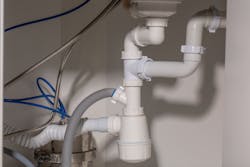NIST Report Outlines Research Needs for Premise Plumbing Systems
WASHINGTON, DC — The National Institute of Standards and Technology (NIST) on Monday published a report titled Measurement Science Research Needs for Premise Plumbing Systems . NIST, one of the nation's oldest physical science laboratories in the United States and part of the U.S. Department of Commerce, issued the report to identify and categorize research needs resulting from changing water use patterns in American homes and buildings due to today’s more efficient plumbing products and appliances.
The report identifies nearly 60 specific research needs that address system design, operation and maintenance, and provides a useful reference for the development of a detailed roadmap for addressing those needs through applied research and codes and standards activities.
The report may be read here: https://nvlpubs.nist.gov/nistpubs/TechnicalNotes/NIST.TN.2088.pdf
Over the years, IAPMO, along with its industry partners, has worked with NIST to address and prioritize research needs on plumbing. In addition, IAPMO has worked with Congress in supporting NIST’s plumbing research efforts. Rep. Matthew Cartwright (D-PA) and Sen. Tammy Duckworth (D-IL) have both introduced legislation in the House and Senate, respectively, on the importance of NIST’s plumbing research, and have continued to find ways to expand research and funding in this important area.
NIST’s report was developed based on several sources of information, including an important Measurement Science Roadmap Workshop that was convened by NIST, the U.S. EPA and the Water Research Foundation in August 2018, a request for public commentary that was published in the Federal Register in October 2018, and input from stakeholders in the plumbing industry, including IAPMO.
Much has changed in the way Americans use water since the 1920s and ’30s when Dr. Roy Hunter, working for the National Bureau of Standards, the predecessor to NIST, developed the Hunter’s Curve model for predicting water use demands based on the number and type of fixtures (fixture units) utilized in a building. While minor updates have been made over the years to Hunter’s Curve, it is still used today in plumbing codes despite the many improvements and efficiencies made to plumbing fixtures, appliances and other water using equipment in subsequent years. As a result, it is widely recognized that today’s plumbing systems are grossly oversized, resulting in wasted water and energy and declining water quality.
The report makes note of the IAPMO/ASPE-led research in developing the Water Demand Calculator (WDC), which is available in both the 2021 Uniform Plumbing Code and the 2020 WE-Stand - Water Efficiency and Sanitation Standard.
“The NIST Report points to the WDC as a milestone for the way to estimate peak water demand for water-conserving plumbing systems,” said Dan Cole, IAPMO Senior Director of Technical Services. “We anticipate this will be a priority research need for extending the applicability of the WDC for all building types. We will continue our leadership in this effort with NIST to achieve the research goals of water efficiency and improved water quality.”
NIST will utilize the report to plan future research activities that will address many of the needs discussed in the report. IAPMO representatives say the association plans to continue its close collaboration with NIST and looks forward to playing a leadership role in other research programs that support safe and efficient plumbing systems.
